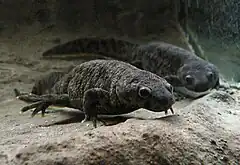| Pleurodeles[1] | |||
| Michahelles, 1830[2] | |||
 Przedstawiciel rodzaju – traszka Waltla (P. waltl) | |||
| Systematyka | |||
| Domena | |||
|---|---|---|---|
| Królestwo | |||
| Typ | |||
| Podtyp | |||
| Gromada | |||
| Rząd | |||
| Rodzina | |||
| Podrodzina | |||
| Rodzaj |
Pleurodeles | ||
| Typ nomenklatoryczny | |||
|
Pleurodeles waltl Michahelles, 1830 | |||
| Synonimy | |||
|
| |||
| Gatunki | |||
| |||
Pleurodeles – rodzaj płazów ogoniastych z podrodziny Pleurodelinae w rodzinie salamandrowatych (Salamandridae).
Zasięg występowania
Rodzaj obejmuje gatunki występujące na Półwyspie Iberyjskim w Hiszpanii i Portugalii oraz w Maroku, Tunezji i Algierii[7].
Systematyka
Etymologia
- Pleurodeles: gr. πλευρα pleura „bok”; δηληεις dēlēeis „szkodliwy”[9].
- Bradybates: gr. βραδυς bradus „powolny”; βατης batēs „piechur”, od βατεω bateō „stąpać”, od βαινω bainō „iść”[10]. Gatunek typowy: Bradybates ventricosus Tschudi, 1838 (= Pleurodeles waltl Michahelles, 1830).
- Glossoliga (Glossolega[uwaga 2]): gr. γλωσσα glōssa „język”; λιγυς ligus, λιγεια ligeia „głośny, przenikliwy”[9]. Gatunek typowy: Triton poireti Gervais, 1835.
- Bradytes: gr. βραδυτης bradutēs „ociężałość, powolność”[11]. Nazwa zastępcza dla Bradybates[7].
Podział systematyczny
Do rodzaju należą następujące gatunki[7]:
- Pleurodeles nebulosus (Guichenot, 1850)
- Pleurodeles poireti (Gervais, 1835) – żebrowiec algierski[12]
- Pleurodeles waltl Michahelles, 1830 – traszka Waltla[13]
Uwagi
Przypisy
- ↑ Pleurodeles, [w:] Integrated Taxonomic Information System (ang.).
- ↑ K. Michahelles. Neue südeuropäische Amphibien. „Isis von Oken”. 23, s. kol. 191, 1830. (niem.).
- ↑ J.J. von Tschudi: Classification der Batrachier mit Berücksichtigung der fossilen Thiere dieser Abtheilung der Reptilien. Neuchâtel: Petitpierre, 1838, s. 91. (niem.).
- ↑ Ch.L. Bonaparte: Iconographia della Fauna Italica per le Quattro Classi degli Animali Vertebrati. T. 2: Amphibi. Rome: Salviucci, 1839, s. nienumerowana. (wł.).
- ↑ J. von N.F.X. Gistel: Naturgeschichte des Thierreichs für höhere Schulen. Sttutgart: Hoffmann, 1848, s. xi. (niem.).
- ↑ E.D. Cope. On the structures and distribution of the genera of the arciferous Anura. „Journal of the Academy of Natural Sciences of Philadelphia”. Second Series. 6, s. 108, 1866. (ang.).
- 1 2 3 4 5 D. Frost: Pleurodeles Michahelles, 1830. [w:] Amphibian Species of the World 6.1, an Online Reference [on-line]. American Museum of Natural History. [dostęp 2022-05-21]. (ang.).
- ↑ G.A. Boulenger. Quelques mots sur les Euproctes. „Bulletin de la Société zoologique de France”. 3, s. 308, 1878. (fr.).
- 1 2 L. Agassiz: Nomenclator zoologicus: continens nomina systematica generum animalium tam viventium quam fossilium, secundum ordinem alphabeticum disposita, adjectis auctoribus, libris, in quibus reperiuntur, anno editionis, etymologia et familiis, ad quas pertinent, in singulis classibus. Soloduri: Jent et Gassmann, 1842–1846, s. 1–48, 1–8. (łac.).
- ↑ bradybates, [w:] The Key to Scientific Names, J.A. Jobling (red.), [w:] Birds of the World, S.M. Billerman et al. (red.), Cornell Lab of Ornithology, Ithaca [dostęp 2021-12-27] (ang.).
- ↑ Edmund C. Jaeger, Source-book of biological names and terms, wyd. 1, Springfield: Charles C. Thomas, 1944, s. 34, OCLC 637083062 (ang.).
- ↑ Praca zbiorowa: Zwierzęta: encyklopedia ilustrowana. Warszawa: Wydawnictwo Naukowe PWN, 2005, s. 424. ISBN 83-01-14344-4.
- ↑ J. Mazgajska: Płazy świata. Warszawa: Wydawnictwo Naukowe PWN, 2009. ISBN 978-83-01-15846-0.
This article is issued from Wikipedia. The text is licensed under Creative Commons - Attribution - Sharealike. Additional terms may apply for the media files.